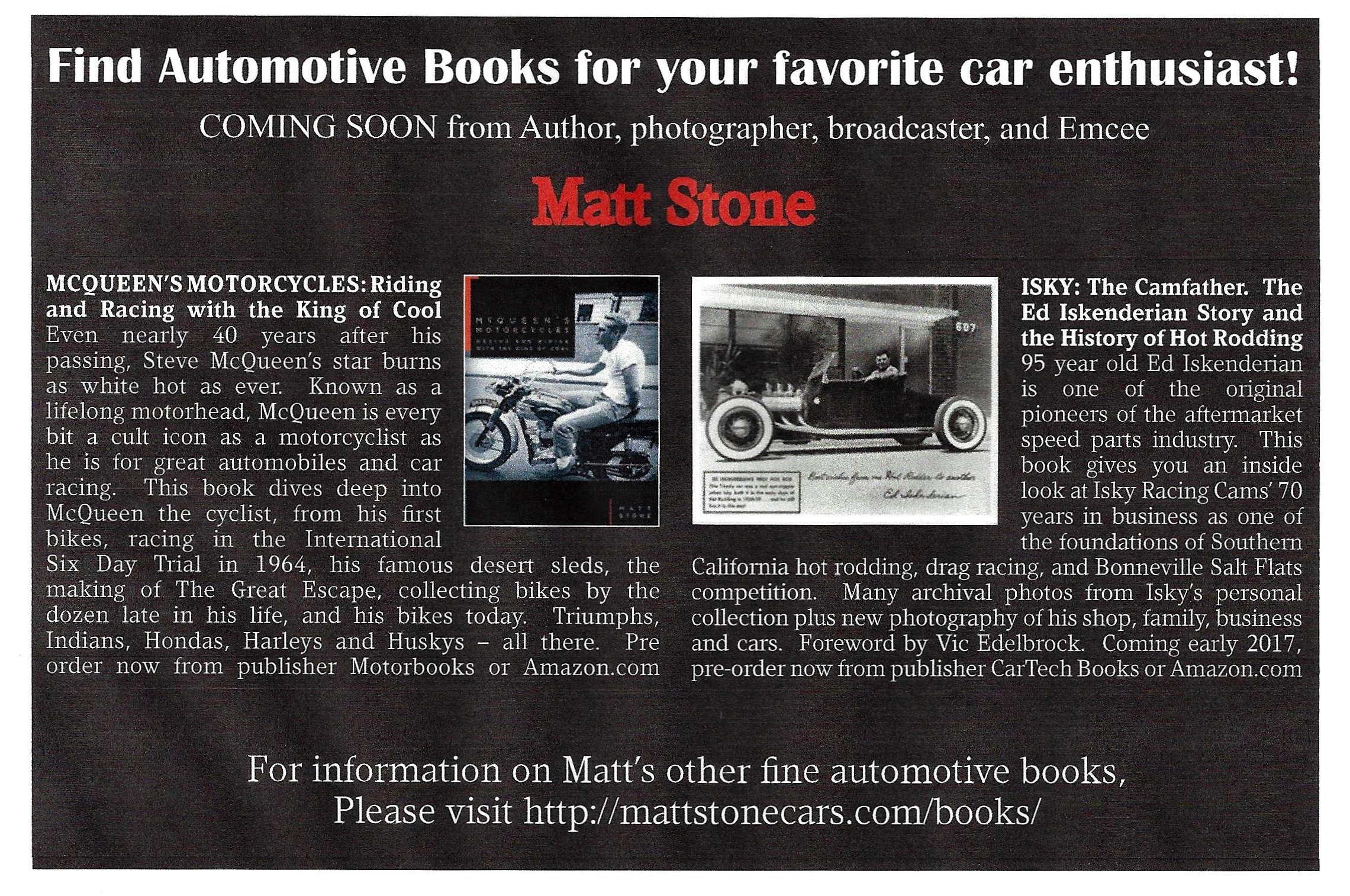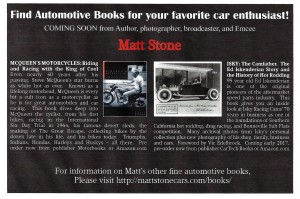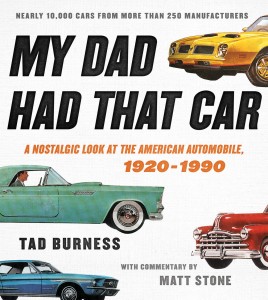I’m pleased to advise you that I’ll have three new books out early next year.
The first is the next step in my ongoing Steve McQueen as Hollywood Car Guy series, this time about Steve as cyclist. Its called McQueen’s Motorcycles, all about Steve’s success as a motorcycle racer, and also about the hundreds of bikes he owned over his legendary life. This one published by Motorbooks.
If you’re at all or in any way a hot rodder, you know the name Isky. As in Ed Iskenderian, and his Isky Racing Cams. Isky himself was among the early pioneers of the performance aftermarket parts industry, and over time guys like Don Garlits and Mickey Thompson ran his cams in their race cars. Isky is still with us, and a mere 95 years old, and it was my honor to spend half a year with him putting this book together. Coming to us courtesy of CarTech Books.
The third is the rebirth and reinvention of Tad Burness’s original Monster Car Spotter’s Guide. Here’s my Foreword from the reborn version, now entitled My Dad Had That Car.
By the time I was 10 years old, I could identify nearly every car on the road – by year, make, model, and possibly engine spec. Remember, there was no Google back then. I learned it all the old fashioned ways, from my father (a serious car guy), from the pages of MOTOR TREND and ROAD&TRACK magazines, and by making my dad take me to every new car dealership on Holt Boulevard in Ontario, California, each fall, when all the “next year’s” models premiered. We cruised the lots and I collected sales brochures (some of which I still have).
Mostly I just paid attention to what was on the road, often with my camera around my neck to snap my own photos. What I didn’t have was the late Tad Burness’s original Monstrous American Car Spotter’s Guide. Think of a single book, as large as any Webster’s dictionary, with omore than 1000 pages and 10,000 illustrations of every American car, make, and model from 1920-1980. It weighed more than most notebook computers do these days.
Mr. Burness hit upon a somewhat magical format with this encyclopedic collection of copious illustrations combined with a surprising amount of detailed information about these many thousands of cars. Now a professional automotive writer and book author, it is my honor to assist in the freshening, updating, and republishing Mr. Burness’s original “Google on paper” guidebook to nearly every American car built from 1920 to 1990; the original volume only went through 1980s, with a subsequent version that came along later, extending the window of coverage, through 1990. I find it interesting that these wonderful books, first published in 1970, grew out of Mr. Burness’s own scrapbooks which he assembled to share with his friends at car club meetings. These imaginative books have been out of print for more than a decade, and now, combined into one even more massive volume, wearing a new name, it’s back! I hope you missed this storehouse of information and charming presentation as I have.
The effort necessary to create or procure the more than 10,000 photos and illustrations in the original Spotter’s Guide was considerable, particularly so in the time before computerized assistance. The table of contents and indices will help you zero in on the specific make or model you may initially be most interested in, but the fun way to enjoy this amazing material is to start at the beginning with Ace, produced from 1920-22 in Ypsilanti, Michigan, then slowly browse through page by page, year by year, make by model, and I promise you that nearly every page will surprise and delight you. You’ll discover car brands you’ve never heard of, models you’ve never seen, produced in places you never dreamt built cars.
Why did Mr. Burness decide only to include American cars? We’re not sure, as he doesn’t explain this motivation in any of his text, but perhaps this is what interested him the most or that gathering solid information and enough photos and illustrations from around the (pre-internet) world would have been too arduous an undertaking. He did, howeve Mr. Burness covers American cars up and down the spectrum, from the smallest, least expensive or prestigious, up to the largest, most powerful, and most costly makes.
You may be surprised to know that Illinois was once a hotbed of automotive production. Plus Indiana and New Jersey. They even built cars in my car buddy Bill Thornley’s current hometown of Fullerton, California (that of course would be the Balboa brand of automobiles, produced from 1923-1925, running a powerful 100 horsepower, 178 cubic-inch supercharged Kessler straight-8 engine). You’ll see the car brands that did and didn’t survive the Great Depression and World War II, and all the rest that succeeded or failed of their own accord.
While you won’t find pages of specifications tables, there are a surprising number of factoids and interesting sidenotes on every page, some of which you won’t find on the internet. I’ll bet you didn’t know that Briggs & Stratton, of Milwaukee, the company that may have made the single cylinder engine in your lawn mower, also produced cars from 1919-1923. And the illustrations will show you that they were little more than a buckboard with bicycle-type spoke wheels and fenders . Given that the text is spare, and space is at a premium on these highly illustrated pages, Mr. Burness did a lot of abbreviating, such as “C.I.D. “for Cubic Inches Displacement, “WB” for Wheelbase, and ‘F.O.B. for “Freight on Board” which was a common descriptor of giving price information for what the vehicle cost prior to shipping from its factory, such as $895 Freight on Board, Detroit” in other words that the price quote doesn’t include shipping.
With this book, I assure you an enjoyable and nostalgic walk through American automotive history and design. The illustrations are detailed and delightful, and many of the photographs are the carmaker’s own advertising, sales brochure or public relations still shots. The photos are black and white, which lends a wonderful archival quality to the presentation.
And if you’re talking about a 1934 Ford 3-window coupe, a 1946 Ford Tudor Deluxe, a 1952 Ford Customline V-8, or a 1963 Lincoln Continental hardtop sedan, 1983 Mustang GT Turbo, then yeah – My Dad Had That Car!
This is the kind of visual, written, and graphics information that hooked me on cars back in the 1960s, and I’m sure will equally ignite, or reinvigorate your passion for collector cars. I’m privileged to be a part of the rebirth of Tad Burness’s great original work and vision.
Enjoy.




